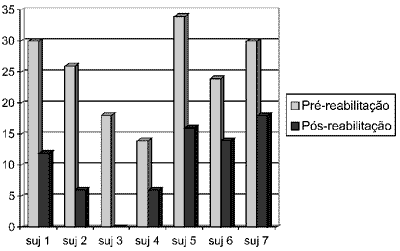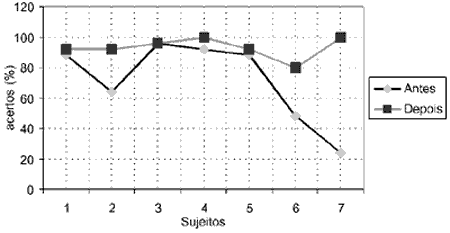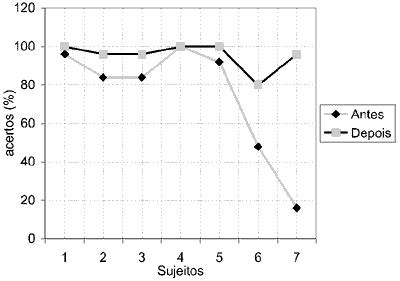

Year: 2004 Vol. 70 Ed. 6 - (16º)
Artigo Original
Pages: 806 to 812
Auditory rehabilitation in the elderly
Author(s): Ana Cléia de O. Marques , Lorena Kozlowski , Jair Mendes Marques
Keywords: Key words: elder, hearing loss, handicap auditory.
Abstract:
Summary
Introduction: One of the most incapacitating sensorial alterations in the process of growing old is the auditive deficiency known as presbycusis. This alteration reduces social contacts, causing emotional problems, which are frequently overwhelmed. In addition to the auditory limitation due to acquired auditive deficiency, an auditive handicap appears, related to non-auditive aspects and to emotional and social alterations. Material and Method: Seven subjects, three of the male and four of the female, from 60 to 77 years old, were studied. They presented bilateral sensoneural hearing loss and used unilateral hearing aid. Seven auditive rehabilitation sessions were held, lasting one hour each, once a week and in group. Speech reading of all phonemes of Portuguese language was used. Results: A significant reduction of the auditive handicap perception was verified in all the subjects, at the end of seven sessions. This result was established by using the HHIE-S questionnaire pre and post rehabilitation. Conclusion: In order to diminish psycho social reactions of aged people, due to auditory deficiency, its is necessary to indicate, select and adapt hearing aid, parallel to auditive rehabilitation programs in order to help elder with auditory deficiency and their families to deal positively with the difficulties of communication. Through auditive rehabilitation programs it is possible to reduce the auditive handicap perception of old population. This will give old a better quality of life, encourage their social contacts and lessen their loneliness.
![]()
INTRODUCTION
Brazil is predominantly a young country, but as a result of medical advance and health preservation, life expectancy is increasing, contributing to longer life and, consequently, to expansion of the elderly population. Even though it is representative of the current reality, the effects of aging over the sensorial capabilities of humans have not been modified.
The aging process is global, deteriorating and irreversible. Among the sensorial abnormalities that follow this process, hearing loss or reduction of auditory function, known as presbyacusis, is one of the most disabling. The sensorial deprivation makes the elderly gradually reduce their social contact, promoting emotional disorders that are many times devastating.
Etymologically, presbyacusis means "elderly hearing", since it is triggered with the advance in age, as well as how it affects the body as a whole (Hungria, 2000).
Corso (1977) characterized presbyacusis as bilateral hearing loss in high frequencies owing to degenerative and physiological changes to the auditory system as the age advances.
Bess et al. (2001) pointed to sensorineural loss found in the elderly as a frequent consequence of the aging process, and hearing loss in this population is one of the three most prevalent chronic conditions, second only to arthritis and hypertension. They also reported that the hearing system during aging normally presents loss of sensitivity in thresholds and reduction in speech understanding at comfortable levels.
Elderly subjects with presbyacusis experience reduction in auditory sensitivity and reduction in speech intelligibility at supraliminar levels, which seriously affects the verbal communication process. Russo (1999) described that all sensorial deprivations due to inability to communicate with other people owing to hearing loss can bring extremely frustrating consequences to subjects.
In addition to auditory limitation resulting from the acquired hearing loss, other problems should be highlighted, such as: hearing inability and auditory deficit (handicap). The first is related to speech perception in noisy environments, TV etc. The second refers to non-auditory aspects, which prevent subjects from appropriately performing their role in society (Russo and Almeida,1995).
To minimize psychosocial reactions of elderly in view of the presented aspects, it is necessary to select, indicate and fit the hearing aids together with a global auditory rehabilitation program, supporting the elderly with hearing loss and their family members (Russo, 1999). Therefore, attention to psychosocial aspects and development of communication strategies, among which orofacial reading, deserve special attention to facilitate communication and improve quality of life of the subjects.
Using questionnaires to assess emotional and social issues resulting from hearing loss it is possible to quantify self-perception of each subjects' handicap. Ventry and Weinstein (1982) developed the questionnaire Hearing Handicap Inventory for the Elderly (HHIE), whose objective is to assess the impact of hearing loss in emotional and social/situational adjustment of non-institutionalized elderly subjects. The authors suggested its use for counseling, as well as in auditory rehabilitation programs and in assessing the benefits of the use of amplification, allowing changes in self-perception of the handicap.
According to Boèchat (1992), communication strategies form a set of specific attitude that work as facilitating agents for the message to be easily received. The author organized communication strategies in different groups depending on their own nature, classifying them into cognitive, intervention, mechanical, palliative, remediation, desisting and simulating strategies.
In addition to communication strategies as facilitating agents for effectiveness of communication, the use of orofacial reading is indispensable for this purpose. According to Kozlowski (1997), speech visual processing is used even among listeners, making it part of speech perception. This process occurs mainly when there is unfavorable signal-noise ratio, since phonemes are masked by noise, perceived only by listeners.
Blamey et al. (1989) described that when hearing does not provide appropriate sensorial information on speech, visual and tactile aspects may be used as supplemented or alternative sensorial channels, and they should, therefore, be used to increase communication potential of people with hearing loss.
Walden and Grant (1993) referred that in the first half of the century the base of auditory rehabilitation, both for children and adults, was centered in learning orofacial reading. During the 70's, the popularity of the technique was reduced and counseling replaced it.
However, thanks to technological and scientific advances of hearing aids, and consequently the possibility of fitting various hearing losses' levels and configurations, auditory rehabilitation started to comprise guidance and counseling in use of hearing aids and training of orofacial reading (McCarthy and Alpiner,1982).
Hull (1989) referred the importance of introducing the elderly with hearing difficulties in an auditory rehabilitation program, in which training in orofacial reading should be emphasized, suppressing communication difficulties found when using only hearing aids. It was reported that 1992, counseling was one of the most important aspects in an auditory rehabilitation program, which consisted of: 1) counseling; 2) guidance on how to use the hearing aids; 3) help to make the elderly manipulate the environment to favor communication; 4) help the elderly speak about the hearing loss so that people can help them; 5) develop compensation skills using residual hearing and supplemented visual clues; 6) participation of family member or friends in the program.
Russo and Almeida (1995) reported that the program directed to elderly has been limited to diagnosis and indication of hearing aids, performed by speech and hearing therapists, requiring a more comprehensive approach of these subjects so that they can have more effective verbal communication.
In view of these facts, the present study aimed at checking efficacy of the auditory rehabilitation program in reducing auditory handicap using communication and orofacial reading training strategies.
MATERIAL AND METHOD
The study gathered 7 elderly subjects aged 60 to 77 years, 3 male and 4 female patients with sensorineural hearing loss (presbyacusis). All subjects were users of unilateral, behind-the-ear and digital hearing aids. The exclusion factors in the study were age below 60 years and conductive and mixed hearing loss. The hearing loss level was not considered an exclusion factor. To calculate the level of hearing loss, we used the classification by Davis and Silvermann (1970) (apud Russo and Santos,1993).
According to the current legislation concerning research studies in human beings, the present study was approved by the Ethics Committee of Universidade Tuiuti do Paraná.
The materials used for the present study were: reduced version of the questionnaire HHIE (HHIE-S) and speech perception tests with monosyllable and dissyllable words.
The questionnaire is a screening version with 10 items gathered from HHIE by Ventry and Weinstein (1982) which was developed to assess the impact of hearing loss in emotional and social adjustment of elderly patients. The patients answered the questions related to hearing by recognizing whether the situation represented a problem or not. Negative response was equivalent to zero, "sometimes" was equivalent to two, and positive response was equivalent to four points. The likelihood of hearing loss being predicted based on the total result was: 0-8= 13%; 10-24=50%; 26-40=84% of likelihood of hearing loss.
In the speech perception test we used 4 lists of monosyllable and disyllable words proposed by Lacerda (1976). The presentation of the words was made in front of the patient to assess the subjects' skills to integrate visual and auditory clues before the training process with orofacial reading and after it.The program consisted of 7 one-hour sessions in group, which comprised:
-First session: Individual application of Questionnaire HHIE-S and speech perception test with monosyllable and dissyllable words with orofacial reading. We instructed the members of the group about the activities to be performed and they introduced themselves.
-Second session: Training of orofacial reading (OFR) of isolated phonemes /p/ and /b/, in words and sentences. Guidance on communication strategies: "Pay attention to speaker, not only to the lips, but also to expressions and gestures; - The speaker's face should always be in front of you; - Do not hesitate to guess; - Inform your family and/or friend that you are studying OFR". Guidance on care and handling of hearing aids. We informed the patients to bring a family member or friend in the next session.
-Third session: Guidance to family members about the objective of the group. Explanations about hearing physiology and auditory difficulties related to presbyacusis. Training of isolated phonemes /t/ and /d/, in words and sentences. Presentation of 3 new communication strategies: "Try to relax, tension interferes in facial reading skills; Remember that you will use residual hearing together with orofacial reading skills; Learn how to look for ideas rather than for isolated words."
-Fourth session: Participation of the family. Training of isolated phonemes /f/ and /v/, in words and in sentences. Presentation of 3 new strategies: "Do not be afraid to speak; Use key in situations to figure out their meaning; Maintain the good mood." Dynamic exercise with family members and elderly patients.
-Fifth session: Training of isolated phonemes /m/, /n/ and /l/, in words and in sentences. Presentation of 4 new strategies: "Be aware of the events; Keep updated on topics that interest your friends; Be flexible and change your mind when necessary; Observe your own speech".
-Sixth session: Training of isolated phonemes /k/, /g/, /r/, /s/ and /S/, in words and in sentences.
-Seventh session: Application of questionnaire HHIE-S and speech perception test with monosyllable and dissyllable words with OFR and final comments about the results of participants.
RESULTS
Based on the results obtained in the HHIE-S questionnaire before and after the auditory rehabilitation, we conducted statistical analysis using Wilcoxon test. The results showed significant reduction of auditory handicap perception in all subjects of the study, and the significance level of 5% ( = 0.05), p = 0.017966 < ? = 0.05.
The results of the score of each subject in the HHIE-S questionnaire before and after the rehabilitation are presented in Table 1.
Through Graph 1 it is possible to check the variation before and after the rehabilitation.
The speech perception test with monosyllable words (Graph 2) and dissyllable words (Graph 3) was conducted before and after auditory rehabilitation, showing the results displayed below.
Based on these results it was possible to confirm the improvement in speech perception for monosyllable words after rehabilitation in most subjects in the study, except for subject 3 that presented 96% of discrimination before it and maintained the same percentage after rehabilitation.
These results demonstrated that there was improvement in perception of dissyllable words, observed in most of the subjects except for subject 4, who presented 100% pre-rehabilitation discrimination, maintaining the same post-rehabilitation percentage.
DISCUSSION
The reduction in perception of auditory handicap occurred in all subjects in the study after they participated in the auditory rehabilitation program based on orofacial reading training and guidance of situational and behavioral strategies.
Many authors (Hull, 1982; Russo and Almeida, 1995) suggested the inclusion of elderly subjects with hearing loss in programs as the ones described above, given that they are directed to selecting and fitting hearing aids which are sometimes rejected when they do not compensate all hearing difficulties manifested by the elderly.
After participating in the program of auditory rehabilitation, subjects began to better integrate auditory and visual channels and improved their communication potential, as described by Blamey et al. (1989).
CONCLUSION
To minimize psychosocial reactions resulting from the hearing loss in the elderly, it is necessary to conduct a comprehensive auditory rehabilitation program that aims at working supplementary strategies that will contribute to greater communication efficiency associated with use of hearing devices.
The program helps the elderly and their family members to positively deal with communication difficulties that are present in daily life situations.
Auditory rehabilitation is effective in reducing auditory handicap in elderly subjects with hearing loss and should be included in the routine of the audiologist as a resource as important as fitting the hearing aids.
REFERENCES
1. Hungria H. Otorrinolaringologia. Rio de Janeiro: Ed. Guanabara Koogan; 2000. p. 443-7.
2. Corso JF. Presbyacusis hearing aids and aging audiology. 1977; 16(2): 146-63.
3. Bess FH, Hedley-Williams A, Lichtenstein MJ. Avaliação Audiológica em idosos. In: Musiek FE, Rintelmann WF. Perspectivas Atuais em Avaliação Auditiva. São Paulo: 1ª ed. 2001. p. 343-69.
4. Russo ICP. Distúrbios da Audição: A Presbiacusia. In: Russo ICP. Intervenção Fonoaudiológica na Terceira Idade. Rio de Janeiro: Ed. Revinter; 1999. p. 51-92.
5. Russo ICP, Almeida K. O Processo de Reabilitação Audiológica do Deficiente Auditivo Idoso. In: Marchesan IQ, Bolaffi C, Gomes ICD, Zorzi JL. Tópicos de Fonoaudiologia. São Paulo: Ed Lovise; 1995. p. 430-47.
6. Ventry IM, Weinstein BE. The Hearing Handicap Inventory for the Elderly: a new tool. Ear Hear 1982; 3: 128-34.
7. Boéchat EM. Ouvir sob o prisma da estratégia. São Paulo; 1992. Dissertação (Mestrado em Distúrbios da Comunicação Humana) - Pontifícia Universidade Católica de São Paulo.
8. Kozlowski L. A percepção Auditiva e Visual da Fala. São Paulo: Ed. Revinter; 1997.
9. Blamey PJ, Cowan RSC, Alcantara JI, Whitford LA, Clark GM. Speech perception using combinations of auditory visual and tactile information. Journal of Rehabilitation Research and Development 1989; 26: 15-24.
10. Walden BE, Grant KW. Research Needs in Rehabilitative Audiology. In: Alpiner JG, McCarthy PA. Rehabilitative Audiology: Children and Adults. Baltimore: 2a. Ed. Williams & Wilkins; 1993. p. 500-28.
11. McCarthy PA, Alpiner JG. The Remediation Process. In: Alpiner JG. Handbook of Adult Rehabilitative Audiology. Baltimore: 2a. Ed. Williams & Wilkins; 1982.
12. Hull RH. Techniques of Aural Rehabilitation Treatment For Older Adults. In:_____. Aural Rehabilitation. San Diego: 2a. Ed. Singular Publishing Group Inc.; 1992. p. 278-92.
13. Hull RH. Assistência ao paciente Idoso. In: Katz J. Tratado de Audiologia Clínica. São Paulo: Ed. Manole; 2000. p. 1063-74.
14. Lacerda AP. Audiologia Clínica. Rio de Janeiro: Ed. Guanabara Koogan; 1976.
Table 1. Score of questionnaire HHIE-S before and after auditory rehabilitation.
Before rehabilitation After-rehabilitation
Subject 1 30 12
Subject 2 26 6
Subject 3 18 0
Subject 4 14 6
Subject 5 34 16
Subject 6 24 14
Subject 7 30 18
Mean 25.3 10.3
Considering subjects 1,5,6 and 7, we could observe that self-perception of deficit ranged from "significant severe perception" (from 24 to 40 points) to "mild moderate perception" (from 10 to 22); subject 2 ranged from "significant severe perception" to "there is no perception" (from 0 to 8); subjects 3 and 4 ranged from "mild moderate perception" to "there is no perception".
QUESTIONNAIRE HHIE-S (Ventry and Weinstein, 1983)
INSTRUCTIONS: The purpose of the present questionnaire is to identify auditory problems that the hearing loss might be causing you. Answer "YES", "NO" or "SOMETIMES" to each question. Do not skip any of the questions even if you avoid the situation because of the hearing problem.
E- 1. Does your hearing problem make you embarrassed when you meet someone?
() YES () NO () SOMETIMES
E- 2. Does your hearing problem make you feel frustrated when you talk to family members?
() YES () NO () SOMETIMES
S- 3. Can you hear well when someone whispers?
() YES () NO () SOMETIMES
E- 4. Do you feel diminished because of your hearing problem?
() YES () NO () SOMETIMES
S- 5. Does your hearing problem bring your difficulty when visiting friends, relatives or neighbors?
() YES () NO () SOMETIMES
S- 6. Does your hearing problem make you go to church less frequently than you would like to?
() YES () NO () SOMETIMES
E- 7. Does your hearing problem trigger fights with family members?
() YES () NO () SOMETIMES
S- 8. Does your hearing problem cause you trouble to listen to TV or the radio?
() YES () NO () SOMETIMES
E- 9. Do you think that such situations limit your personal and social life?
() YES () NO () SOMETIMES
S- 10. Does your hearing problem cause you difficulties in restaurants with relatives or friends?
() YES () NO () SOMETIMES
Graph 1. Difference in score of questionnaire HHIE-S before and after auditory rehabilitation.
Graph 2. Difference in the speech perception test with monosyllable words before and after auditory rehabilitation.
Graph 3. Difference in the speech perception test with dissyllable words before and after rehabilitation.


